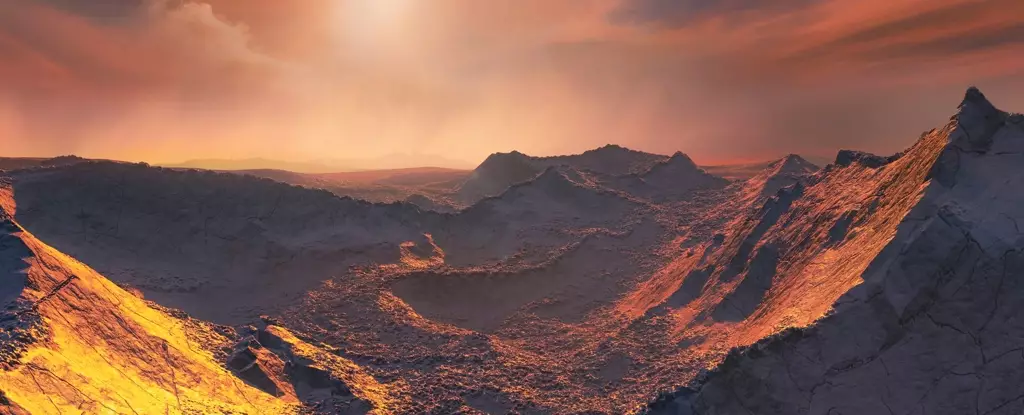In a groundbreaking discovery, astronomers have stumbled across a new Super-Earth named TOI-715b. This exoplanet orbits an M-dwarf star approximately 137 light-years away from us. What is particularly intriguing about this finding is that the Super-Earth is situated within the star’s habitable zone. Additionally, there is another planet candidate in the system, potentially making this system even more captivating. In this article, we will delve into the details of this discovery, discuss the significance of the Super-Earth’s location, explore the existence of a planetary gap, and highlight the implications of further exploration.
TOI-715b, with a radius 1.55 times that of Earth, is quite an intriguing discovery. Its close proximity to the star allows it to complete an orbit in just 19 days. As a result, it resides within the conservative habitable zone (CHZ), where the conditions for liquid water formation are relatively favorable. However, it is vital to recognize that the concept of a habitable zone is not straightforward. The boundaries are subject to change and can be influenced by multiple factors such as the planet’s mass, spectral type, albedo, and atmospheric conditions. Nevertheless, the existence of a Super-Earth within the CHZ is still remarkable and ignites our curiosity regarding the possibility of other habitable planets in the universe.
Upon observing thousands of exoplanets, astronomers have detected a peculiar trend: a gap in the population of small planets with radii ranging from 1.5 to 2 times that of Earth. Known as the small planet radius or sub-Neptune radius gap, this phenomenon is also referred to as the Fulton gap or photoevaporation valley. To our surprise, TOI-715b’s radius places it precisely within this gap, which raises intriguing questions about the evolution and formation of planets.
Research suggests that planets in this radius gap typically begin their journey as larger planets but lose mass over time. This mass loss is hypothesized to occur due to the photoevaporation process, where the planet’s host star strips away its outer layers, leading to a reduction in size. The existence of this gap provides astronomers with an opportunity to study the nature of planetary mass loss and further our understanding of the intricate mechanisms involved in planetary evolution.
It is important to acknowledge the uncertainty surrounding the nature of this gap. While it has long been believed to be a radius gap among M-dwarf planets, recent research by Luque & Pallé (2022) proposes the existence of a density gap instead. This discrepancy highlights the need for additional studies to gain a comprehensive understanding of the unique characteristics of exoplanets around M-dwarfs.
This is where the upcoming James Webb Space Telescope (JWST) comes into play. With its unparalleled observational capabilities, the JWST aims to analyze the spectra of exoplanet atmospheres and identify their constituents. TOI-715b, being in close proximity to its star, presents an excellent opportunity for atmospheric characterization. Its frequent transits in front of the star allow for efficient use of the JWST’s time, making it an ideal candidate for transmission spectroscopy observations.
While we await spectroscopic data from the JWST, we can only speculate on the potential habitability of TOI-715b. Its location within the conservative habitable zone initially suggests favorable conditions for life. Furthermore, considering that the star shows a low degree of magnetic activity, in contrast to younger M-dwarfs, the absence of flaring observed in the TESS light curves indicates less sterilizing potential on the planet. Red dwarfs are known for powerful flares capable of stripping atmospheres, a phenomenon which might explain the existence of the photoevaporation valley.
Another element adding to the excitement is the possible existence of another habitable planet in the TOI-715 system. While currently a candidate named TIC 271971130.02, further observations are required to confirm its presence. Nevertheless, these potential outcomes make the TOI-715 system an engaging target for future study.
The prospects for TOI-715 and its unique properties are indeed promising. The discovery of a Super-Earth within the conservative habitable zone sparks intrigue and stimulates further investigation into the possibilities of extraterrestrial life. Moreover, the placement of TOI-715b within the small planet radius gap opens doors to exploring the intricacies of planetary formation and the mechanisms behind planetary mass loss.
As we eagerly look forward to the era of the JWST, we anticipate detailed observations of TOI-715b’s atmosphere, potential habitability, and the revelation of valuable insights into the nature of exoplanets. Only time will tell if this Super-Earth can provide us with answers regarding photoevaporation, the composition of exoplanet atmospheres, and the distribution of exoplanets around red dwarfs. Until then, we can only marvel at the wonders of our universe and continue to uncover its secrets one discovery at a time.
The discovery of TOI-715b, a Super-Earth orbiting within the habitable zone of an M-dwarf star, piques our interest and rekindles the flame of curiosity within us. Its presence within the small planet radius gap and the potential for further exploration make this finding even more captivating. As we await the launch of the JWST, we remain hopeful that TOI-715b will serve as a fascinating target for atmospheric characterization and unveil valuable knowledge about planetary evolution and potentially habitable exoplanets. The TOI-715 system reminds us of the vast possibilities that lie beyond our planet and highlights the importance of continued exploration in our quest to understand the universe.


Leave a Reply